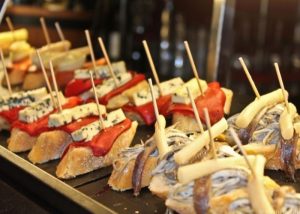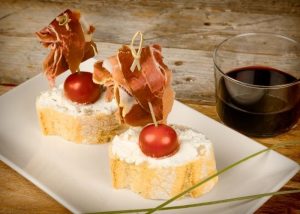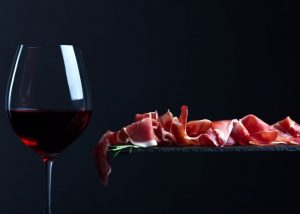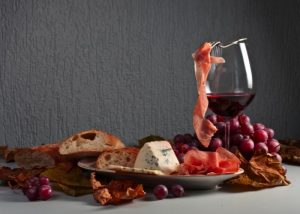As legend goes, tapas originated in Andalucia. The word “tapa” means “cover” which suggests tapas were traditionally offered as a complementary slice of ham served on top of a glass of wine. Today, however, we refer to them as small portions of food commonly served alongside a drink in a bar.
Tapas are also part of a very sociable Spanish tradition. A selection of tapas on a table is more likely to encourage sharing and conversation. This is because people tend to nibble and sip as they chat instead of eating a full meal. Tapas are often provided at no extra cost with each drink.
It is the culture in Spain to have dinner quite late, often from 9pm onwards. Therefore, prior to this time, bar hoping with friends having a drink and a tapa with each round is common. In fact, there are many “rutas de tapas” organised throughout the year in almost every area of Spain.
There are many tales as to how or why tapas were originally created.
The first tale dates to the 13th century, when King Alfonso the 10th of Spain suffered an illness. As a result, he was forced to eat small bites of food with wine (prescribed by his doctor) between meals. When he recovered, he ordered that wine was not to be drunk unless accompanied with something to eat.
Another such story comes from the needs of farmers and other manual workers who needed to take small amounts of food, little and often throughout the day to allow them to continue working until it was time for their main meal. The main meal tended to be rich in fat, and always required a siesta afterwards. If they were able to work longer in the morning eating the tapas, then it meant the workload wasn´t as heavy for them after the siesta.
Because wine was the main accompaniment to the tapa, it meant workers were relaxed and mellow. It provided strength and warmth thus protecting them from the hard work in the cold mornings.
Later taverns were established throughout Spain, King Alfonso´s remained in place. This is when it was started that a tapa was served with every drink in a bar. Each jug of wine was served covered with a slice of jamon or cheese.
Drunken peasants
A similar tale to that of King Alfonso is one where during the 16th century, King Felipe the 3rd had the idea to introduce small snacks while drinking to reduce drunken behaviour from the peasants. Therefore, he ordered bartenders to ensure this was the case.
There are more legends about the history of the tapas such as “The Sevilla Beverage Lid Theory”. In this area, while serving drinks such as Sherry, wine or beer, a saucer was placed on top to help keep flies out. Later, they decided if a small snack were put on the saucer, it would create a better atmosphere and encourage patrons to visit more often and stay longer. Also, if the snacks happened to be salty, then it often meant people drank more. This has a similar ring to the notion of when King Alfonso the 8th visited Cadiz, there was a strong wind, and a saucer was put on top of his glass of sherry to prevent sand from getting in.
Strong cheese and bad wine
At some point in the 16th century, legend has it that in the Castilla-La Mancha region, tavern owners thought that by introducing a slice of strong cheese along with some bad wine, the smell and the flavour of the cheese would detract from the awful taste of the wine. As clients thought they were getting something for nothing by having the “free” cheese, nothing was questioned.
One more common theory is that when bars were very busy and had hardly any bar or table space, patrons were given the small plates with a tapa on top of their drink, so it was easy for them to eat standing up.
The main tapas that started the tradition as we know it know tended to be jamon, cheese, bread, and olives. However, as time has gone on, tapas have become more and more creative and can include almost anything. There are plenty of traditional as well as gastrobars around to sample the variety available.







